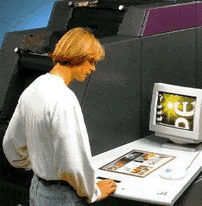

Digital Printing
"Digital printing is an imaging process where all graphic content is in digital form from creation to output." In this case, the definition of digital printing would likely be interpreted to include Computer to Plate (CTP) technologies, Direct Imaging (DI) technologies and all Digital Presses that print without creating any permanent printing plate.
Computer To Plate (CTP)
Various technologies which allow printing plates, mostly offset, to be created directly from the computer and then Various mounted on traditional printing presses.
Direct Imaging (DI)
Direct Imaging Press, that began with Heidelberg in 1990 which allow you to create a static printing plate (or printing surface) at the press itself continue to grow and prosper. The variations are many, from the waterless systems on presses such as the Heidelberg QuickMaster DI, the Ryobi DI and more 'conventional' ink/water systems on Heidelberg, Sakurai and Komori, you can now purchase a Direct Imaging 4, 5 or even 6 color press in sizes from 12" x 18" to 28" x 40".
Digital Printing (DP)
The promise of true digital presses, where a dynamic plate or surface is created just prior to every print impression, has continued to fall short of industry pundit's predictions and expectations. Manufacturers such as Heidelberg NexPress, HP Indigo, Xeikon and Xerox have been offerings in the marketplace that can print in ways which we could not imagine not that long ago. The oldest players in this segment have had working versions of their presses on the market for almost ten years, and thousands have been installed, but the sophistication of these devices and the speed with which the technology has developed has left this segment to a small percentage of print providers, hardy souls with a strong sense of perseverance (Based largely on an article by Mike Chiricuzio Blue Moon Solutions, Inc. From: http://www.ondemandjournal.com/specialfeatures/chiricuzio1.cfm)
 Direct
to Press (DTP).
Direct
to Press (DTP).
This is an overall term meaning any system which goes from a digital file to the press, including automated plate making systems (CTP), direct imaging (DI), and true digital printing (DP) as described above. One company offering fully electronic printing, Directtopress.com, says:
"Digital Printing is Here.............
In a business driven by speed, quality and cost, creating high quality marketing materials can be a tough act. We have risen to this challenge by working effectively to manage costs while utilizing top-of-the-line equipment to ensure fast, reliable output. Our state-of-the-art Heidelberg Quick Master Digital press enables us to go directly from digital images (DISK ) to PRESS. We have, therefore, eliminated the need for film, stripping and platemaking which provides an excellent cost-effective system for producing full color runs of 100 to 50,000 prints." (See: http://directtopress.com/)
Print on demand (POD) is a publishing business model. The main distinguishing mark for print (or publish) on demand is that a copy is not created until after an order is received. While it is conceivable that one could print on demand using any printing technology, digital printing is so often employed that the terms are often used interchangeably. To add to the confusion, Print on Demand is also a trademark of Cygnus Business Media, Inc.
Print on Demand with digital technology is used as a way of publishing books to order for a fixed cost per copy, irrespective of the size of the order. Digital technology is ideally suited to publish small print runs of books and posters (often as a single copy) as and when they are needed. While the unit price of each physical book printed is higher than with offset printing, when setup costs are taken into account digital Print on Demand provides lower per unit costs for very small print runs than traditional printing methods.
(From http://en.wikipedia.org/wiki/Print_on_demand
When printing on demand utilizes true digital printing, which allows for making changes as often and as quickly as desired, personal or individualized printing becomes possible, with individual changes made in each copy of a print job. For example, individual names can be fed to an image from a data base, so that each copy of a print job becomes personal. This allows for more directed target marketing, for example.

![]() Electronic
Publishing
Home Page
Electronic
Publishing
Home Page
Department of Communication, Seton Hall University